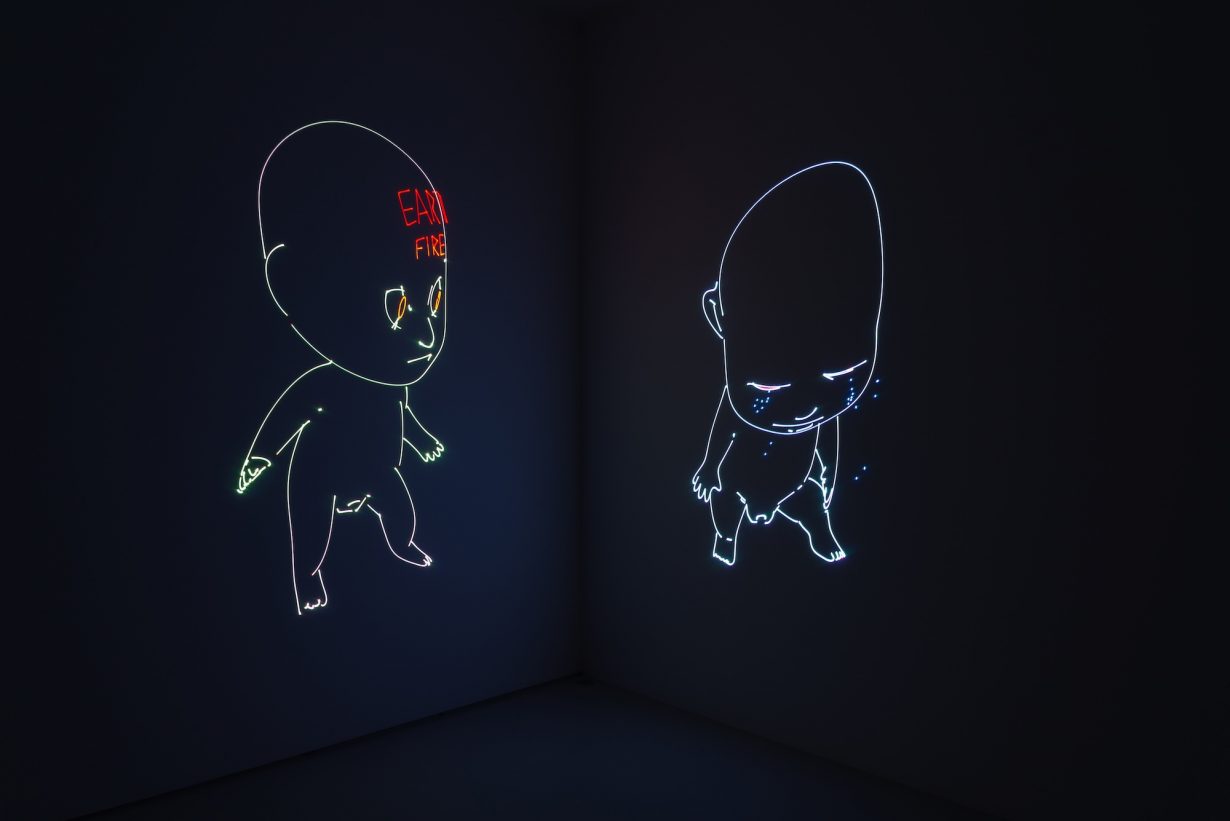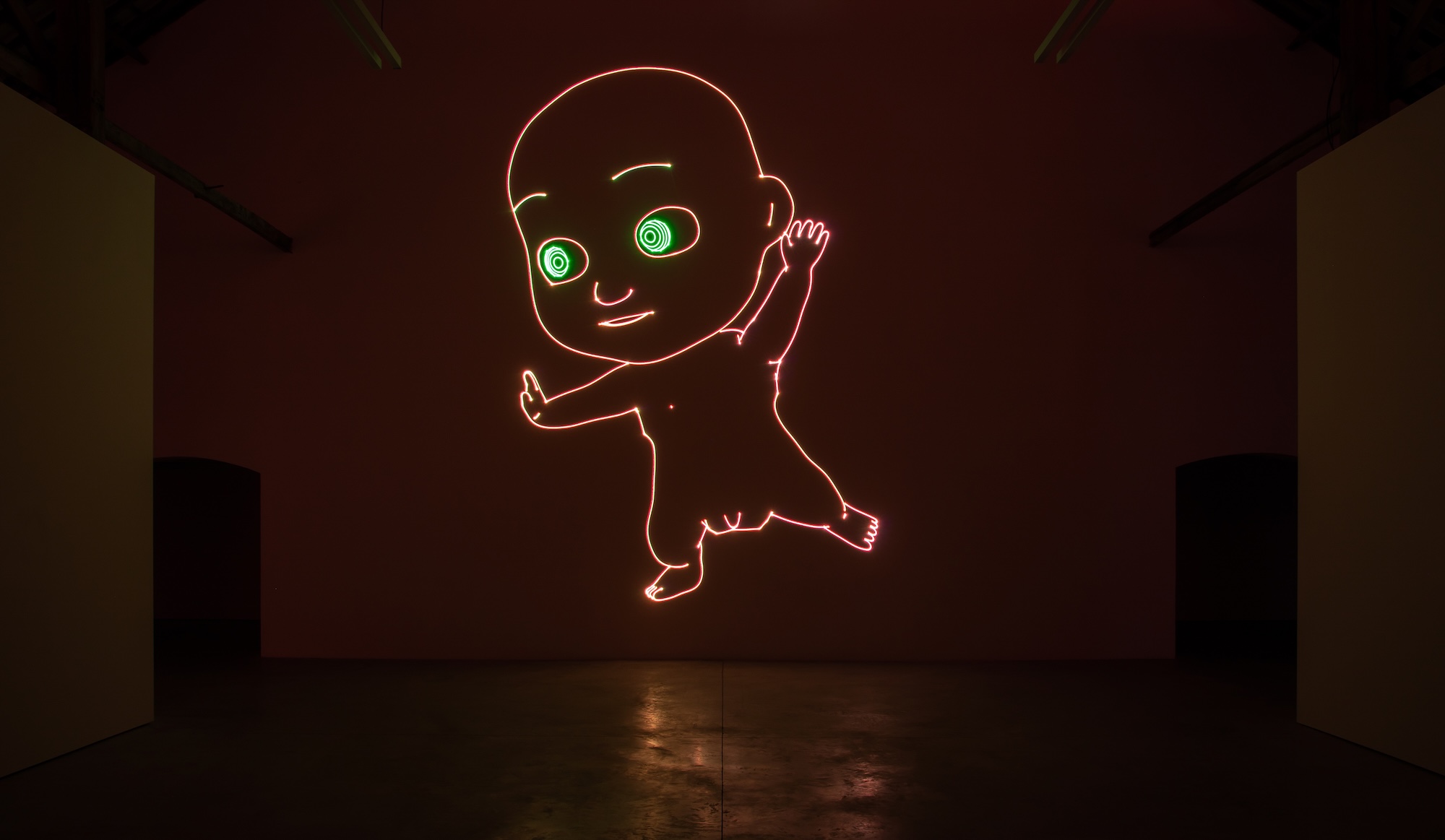“What’s living with no hope?” asks the artist’s big animated baby at KW, Berlin. One thing is certain: we can’t stop watching
Matt Copson’s Coming of Age (Trilogy) (2020–25) is a trio of laser animations depicting cartoonish imagery in glowing, coloured lines, playing sequentially on individual walls in KW’s blacked-out downstairs space, and soundtracked with a libretto sung by a boy soprano. The UK-born, Los Angeles-based artist and theatre director’s project here is seemingly animated, in turn, by two questions. First, what might a hyper-contemporary gesamtkunstwerk (or Wagnerian ‘total work of art’) look like – answered, by Copson’s means of conveying and combining image, language and music, at once high-tech and reaching back towards operatic traditions. And second, how, in a short space of time – 40 minutes – might a caring response to fictional, near-intangible, technology-shaped characters be generated? By, in this case, focusing on a helpless baby, or multiple babies, going through a bad, confusing time and then vaporising?
Things kick off with Coming of Age, where we meet the bairn in its crib. It cries, fights for a wand that becomes a fiery paintbrush, promptly draws another bright linear babe, which promptly pisses despoiling laser piss. As harpsichords trill, the second baby kills the first, then births a couple more crying infants out of a hole in its chest; multiple babies swim skyward into nothingness; the sequence ends. While all this goes on, Copson’s flutily sung libretto unfolds in several parts: “My integrity was compromised at birth… Oh mother, this freedom is a joke!” the singer affirms near the start. “I wonder – what’s living with no hope?” He then offers this: “Welcome to existence / I’m sorry it’s a shit show” and goes on to sketch the earth “choked by fire – The End”. Yet amid this, while babies are making babies, we hear that “You’re the most beautiful thing I’ve ever seen / And life can be blissful / if truths are left unseen”. Life in these godless terms is shaped by death, only the temporary radiance of things giving existence something resembling meaning.

From here, the trilogy interweaves infantilism, insatiable mindless consumption, reflex savagery and accommodation to doom, hunting for compensation amid it all. In Age of Coming, a laser-baby finds objects raining sequentially down on it from a wobbly ellipse in the sky – book, chair, gun, aeroplane – each of which it catches, breaks apart if necessary and then eats. The baby’s body fills with churning indigestive lightning, the ellipse beams light down at him and turns him into abstract swirly patterns, he is ended. “Progress is fake,” Copson’s singer suggests. “The Void wants cake. Cursed hunger insatiable / Perpetually unsustainable… I want it all.” In Of Coming Age, meanwhile, the (or a) baby swings on a swing: it has, it sings, lost its mother “to the fire”. A chorus, with Anthropocene overtones, repeats: “Strange situation / Earthly castration / Strange situation / Entertaining damnation.” The baby – a proxy if not an apologia for humanity, need it be said – appears never to have had a choice. Eventually, a horizon line rises to swallow it up, the loop starts again and we’re back with the initial baby in its crib, crying.
Coming of Age either suffers from a structural defect or is determined to make you watch it twice: you can’t entirely make out what the singers are singing without recourse to the printed libretto, and if you spend all your time using your phone torch to read it, you don’t see what the lasers are portraying. Such wrinkles aside, Copson very much owns the eccentric, attention-holding aesthetic he’s developed in recent years. His animations fall somewhere between 1980s graphics and nightclub lasers; in a darkened room, at large and cosmic-feeling scale and unhitched from screens so that the whole room feels activated, they’re powerfully impactful – you keep watching, even when the narrative is cloudy. The musical elements are rooted in centuries past but designed to stir emotion; his allegorical storytelling is pinned to the present. All of this, combined, suggests that our present moment asks for an operatic response, but one necessarily filtered through technology, and operates in the service of empathy. For if you can’t relate to being a doomed computerised baby complicit in a surrounding apocalypse, I don’t know what to tell you.
Coming of Age. Age of Coming. Of Coming Age. at KW Institute for Contemporary Art, Berlin, through 5 May
From the May 2025 issue of ArtReview – get your copy.
